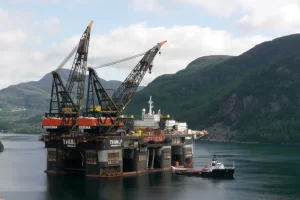Offshore Lift Maintenance: Safety and Reliability at Sea

In the demanding world of offshore operations, lift maintenance is about far more than convenience; it’s a matter of safety, efficiency, and reliability. Whether on board a drilling platform or a naval support vessel, offshore lifts endure extreme conditions and heavy daily use, making regular maintenance essential.
Why Offshore and Naval Vessels Require Frequent Servicing
Unlike the occasional use seen on other vessels, offshore lifts and naval lifts operate continuously, transporting crew, tools, and equipment throughout multiple decks. This constant activity subjects mechanical parts such as door rollers, hydraulic systems, air filters, and steel cables to far greater wear and tear.
To keep operations running smoothly, these lifts require frequent inspection and servicing. Routine checks help identify early signs of fatigue or corrosion caused by the harsh marine environment, preventing costly breakdowns or operational delays. At HML, we provide annual certification, giving vessel operators confidence that their lifts meet stringent safety and performance standards. We follow the design requirements of multiple different inspection agencies around the world, including: American Bureau of Shipping (ABS) Bureau Veritas (BV) Det Norske Veritas (DNV) Lloyds Register of Shipping (LRS) and NORSOK.
Find out more about HML’s annual lift inspections
Skilled Onboard Engineers and Technicians
Working vessels typically employ highly skilled offshore engineers and naval technicians who perform daily or weekly checks on critical systems. These professionals are trained to detect issues such as misaligned doors, frayed cables, or hydraulic leaks before they escalate.
However, certain inspections and recalibrations must be handled by certified specialists. That’s where our offshore technicians come in, bringing expertise in both mechanical and electrical systems. This collaboration ensures every lift continues to perform safely, even under constant operations.
Our Tailored Servicing Approach
We carefully adapt our offshore lift maintenance to the vessel type and operational profile. On offshore platforms and naval ships, where lifts run around the clock, the focus is on functionality and uptime. When components begin to show wear, technicians plan replacements proactively to minimise downtime.
Because these vessels are often located in remote regions, logistics play a critical role. Our engineers frequently coordinate multiple service visits in the same area to reduce travel costs and costs to the client, ensuring rapid response times. If an urgent issue arises, our priority is to restore lift operation as quickly as possible, sometimes sourcing temporary replacement parts from nearby vessels until the correct components arrive.
Functionality Above All Else
In offshore environments, performance always outweighs appearance. Unlike decorative passenger lifts on board superyachts, offshore lifts are designed for strength, corrosion resistance, and reliability in rough sea conditions. Every repair or upgrade is driven by operational necessity, ensuring that personnel and materials can move safely between decks, even in the most demanding weather.
Check out our portfolio of offshore lifts
OPITO Training: The Foundation of Offshore Safety
To operate effectively in offshore environments, our engineers are required to undergo certified OPITO training, the global standard for safety in the oil, gas, and energy industries. OPITO, the Offshore Petroleum Industry Training Organisation, sets internationally recognised benchmarks for offshore personnel safety and competency.
Our engineers complete courses that cover fire prevention, emergency response, sea survival, and first aid. It also introduces trainees to helicopter safety, preparing them for transfers to offshore installations.
This training ensures that every offshore engineer and offshore technician working under HML’s name is equipped to respond calmly and effectively during emergencies. Beyond compliance, an OPITO certification demonstrates our commitment to professionalism, safety, and operational excellence, vital attributes for anyone working in the offshore and naval sectors.
HUET: Helicopter Underwater Escape Training
Complementing the OPITO certification, HUET (Helicopter Underwater Escape Training) is a specialised program that prepares our engineers for one of the most challenging aspects of offshore work, helicopter transfers. As many offshore and naval installations are accessible only by air, this training is mandatory for all engineers who travel to service offshore lifts.
During HUET training, engineers experience simulated helicopter ditching scenarios in a controlled pool environment. The course teaches how to stay calm, unbuckle, orient underwater, and safely escape from a submerged aircraft using breathing apparatus or limited breath control. It also covers survival at sea, life raft procedures, and the correct use of emergency equipment.
For us, HUET certification is more than a safety requirement; it’s a reflection of their operational readiness. Their offshore technicians regularly fly to remote oil platforms and naval vessels by helicopter, often in unpredictable weather conditions. HUET ensures that every engineer can travel confidently and focus on the job at hand, knowing they are fully prepared for any emergency.
Offshore and naval operations demand a level of reliability unmatched in any other maritime field. With constant use, harsh conditions, and critical safety requirements, offshore lift maintenance must be proactive, precise, and expertly managed. Our dedicated offshore engineers and naval technicians combine certified training and exceptional technical expertise to keep lift systems reliable, compliant, and ready for continuous operation across the world’s toughest seas.
Contact HML for your marine vessel’s lift maintenance